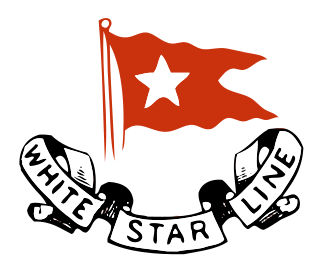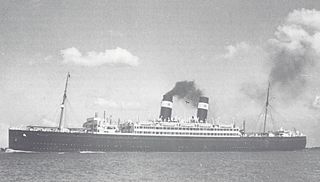
Mitsui O.S.K. Lines is a Japanese transport company headquartered in Toranomon, Minato, Tokyo, Japan. It is one of the largest shipping companies in the world.

The White Star Line was a British shipping line. Founded out of the remains of a defunct packet company, it gradually grew to become one of the most prominent shipping companies in the world, providing passenger and cargo services between the British Empire and the United States. While many other shipping lines focused primarily on speed, White Star branded their services by focusing more on providing comfortable passages for both upper class travellers and immigrants.

The Blue Star Line was a British passenger and cargo shipping company formed in 1911, being in operation until 1998.

The Union-Castle Line was a British shipping line that operated a fleet of passenger liners and cargo ships between Europe and Africa from 1900 to 1977. It was formed from the merger of the Union Line and Castle Shipping Line.

CP Ships was a large Canadian shipping company established in the 19th century. From the late 1880s until after World War II, the company was Canada's largest operator of Atlantic and Pacific steamships. Many immigrants travelled on CP ships from Europe to Canada. In 1914 the sinking of the Canadian Pacific steamship RMS Empress of Ireland just before World War I became largest maritime disaster in Canadian history. The company provided Canadian Merchant Navy vessels in World Wars I and II. Twelve vessels were lost due to enemy action in World War II, including the RMS Empress of Britain, which was the largest ship ever sunk by a German U-boat.

Ellerman Lines was a UK cargo and passenger shipping company that operated from the late nineteenth century and into the twentieth century. It was founded in the late 19th century, and continued to expand by acquiring smaller shipping lines until it became one of the largest shipping firms in the World. Setbacks occurred through heavy losses to its merchant fleet in the First and Second World Wars but were overcome in each case.

Sir William Reardon Smith, 1st Baronet was an English shipowner and philanthropist.

A cargo liner, also known as a passenger-cargo ship or passenger-cargoman, is a type of merchant ship which carries general cargo and often passengers. They became common just after the middle of the 19th century, and eventually gave way to container ships and other more specialized carriers in the latter half of the 20th century.

The Moore-McCormack Lines was a series of companies operating as shipping lines, operated by the Moore-McCormack Company, Incorporated, later Moore-McCormack Lines, Incorporated, and simply Mooremack, founded in 1913 in New York City. It ceased trading on its buy-out in 1982. The founders were Albert V. Moore (1880–1953) (director/president) and Emmet J. McCormack (director/treasurer), with Mr Molloy (director/secretary).

The German ship Doggerbank was a UK cargo ship that was built in Scotland in 1926, captured by the German Navy in 1941, renamed Doggerbank and converted into an auxiliary minelayer and blockade runner. The German U-Boot U-43 (1939) sank her by mistake in 1943, leading to the deaths of all but one of her 257 passengers and 108 crew.

SS Doric was a British ocean liner operated by White Star Line. She was put into service in 1883. Built by the Harland and Wolff shipyards in Belfast, she was the sister ship of the Ionic which was put into service a few months earlier. Although the original purpose of the construction of the two ships was not known with certainty, both began their careers chartered by the New Zealand Shipping Company which operated them on the route from London to Wellington.

SS Zealandic was a British ocean liner initially operated by White Star Line. She was used both as a passenger liner and a cargo ship as well as serving during both world wars.

The Ben Line or Ben Line Steamers, Limited was a Scottish shipping company based in Leith, Scotland founded in 1825 which was primarily involved in the Far East to Europe trade. A private company, it was largely owned by members of the Thomson family from Leith and the Thomson and Mitchell family from Alloa.

Maersk Line is a Danish international container shipping company and the largest operating subsidiary of Maersk, a Danish business conglomerate. Founded in 1928, it is the world's second largest container shipping company by both fleet size and cargo capacity, offering regular services to 374 ports in 116 countries. As of 2024, it employed over 100,000 people. Maersk Line operates over 700 vessels and has a total capacity of about 4.1 million TEU.

The Compagnie Fraissinet, a Marseilles-based shipping line, played an important role in trade and immigration flows in the Mediterranean, Black Sea, Western Africa and Latin America. The Compagnie Fraissinet added Northern America to its routes after a merger with the Compagnie Française de Navigation à Vapeur Cyprien Fabre & Cie. The Compagnie Fraissinet operated for close to 150 years through two World Wars, several revolutions, and the colonization and decolonization periods. The Fraissinet family started divesting from shipping activities in the 60s to concentrate on aviation and media. Fraissinet lowered its flag in 1968, the tanker Alfred-Fraissinet being the last ship of the company. Fabre kept on operating until 1979.

The Oceanic class were a group of six ocean liners built by Harland and Wolff at Belfast, for the White Star Line, for the transatlantic service. They were the company's first generation of steamships to serve the North Atlantic passenger trade, entering service between 1871 and 1872.

SS Pennland was a transatlantic ocean liner that was launched as Pittsburgh in Ireland in 1920 and renamed Pennland in 1926. She had a succession of UK, German and Dutch owners and operators. In 1940 she was converted into a troopship.

SS Afric was a steamship built for White Star Line by Harland and Wolff shipyards. She was of the Jubilee class, had a reported gross register tonnage of 11,948, and had a port of registry of Liverpool, England. Afric was launched on November 16, 1898, and was involved in shipping between Liverpool and Australia.

The SS Scandinavian was a steamship built at Harland & Wolff in Belfast which entered service as an ocean liner in 1898. The ship changed names and owners several times; she was originally built for the Dominion Line and was known as New England, in 1903 she was transferred to the White Star Line and renamed Romanic. In 1912 she was sold to the Allan Line and renamed Scandinavian, the name which she retained for the rest of her career.

























